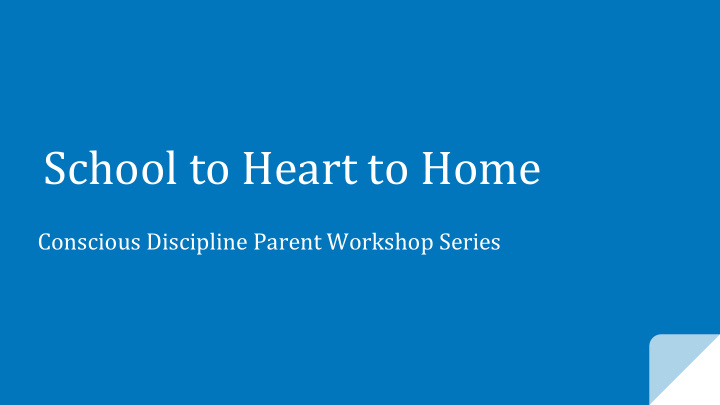



School to Heart to Home Conscious Discipline Parent Workshop Series
What are the learning targets... ● Discover how to access and develop our assertive voice ● How to give assertive commands ● How to get more of what you want (noticing) ● How to effectively handle tattling
1. Composure The 7 2. Assertiveness 3. Encouragement Powers of 4. Choices Conscious 5. Empathy Adults 6. Positive Intent 7. Consequences
Quick Review... Survival State--Safety--Composure, Assertiveness Emotional State--Connection--Encouragement, Choices, Empathy Executive State--Problem solving--Positive Intent, Consequences
The Conscious Discipline Brain State Model
Survival State The Survival State is where we feel triggered by threat. - Flight - Fight - Surrender The only way to soothe the survival state is through the creation of safety.
Emotional State In the Emotional State we are triggered when things are not going our way. - Limited Empathy - Autopilot - Revert to *old* brain behaviors The only way to soothe an emotional upset state is through connection
Executive State An integrated Executive State allows us to consciously respond instead of automatically react to life events. - Frees - Attunes - Enables The executive state is the optimal state for problem solving and learning.
The Power of Attention ● What you focus on you get more of. ● When you are upset you are ALWAYS focused on what you don’t want. ● We become upset when we resist what is.
Assertiveness Requires • Focusing on the behavior we want to see: “Stop running.” “Walk.” “Don’t be so loud.” “Match your voice to mine.” • The intention of helping children be successful: Teach instead of punish. • A tone of voice that has no doubt in it: Speak in the same matter-of-fact voice you would use to say, “The sky is above me.” • Words and hand motions that clearly tell what to do with Name, Verb, Paint: Name: “Caitlin,” Verb: “Put...” Paint: “ … the block in the box,” while pointing first to the block and then to the box.
Assertive Language Young children’s brains are unable to consistently understand the ‘not’ part of ‘do not.’ The often hear statements such as ‘ don’t touch, don’t hit, don’t yell’ as ‘touch, hit, yet’ resulting in confusion, frustration and more of these unwanted behaviors. To help children understand and behave as we desire, we must shift our focus from what we don’t want to what we do want.
Parent Video- The voice of knowing How do I respond to a child who is ignoring directions? Use a tone that would be used describing something that is. The sky is blue.
A note on Visual Routines as a Support Visual routines are an extension of assertive communication. They clearly communicate our expectations to children in a form that is easy for the brain to understand and encode. Visuals help create safety for children through predictability and consistency. What are some visuals you currently use in your school or home to show children what to do? Video Clip
Handling Temper Tantrums https://www.youtube.com/watch?v=UwuIvk0Hg9U&list=PLSzu2wd92Lf3KRpgyhCTJ3uE19PSHPo6l&t=0s&index=2 1. Bring your calm 2. Describe and offer empathy 3. Leave the child alone or hold them and breathe 4. Complete the triggering task
Wrap Up: Turn and Talk- When am I using passive and aggressive voice? When can I try using my assertive voice? What might be a time of the day that you could use a visual routine to help support your assertive communication with your child?
Recommend
More recommend